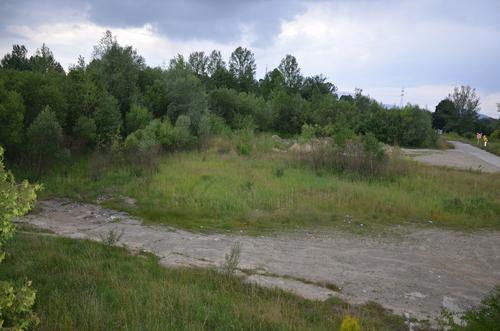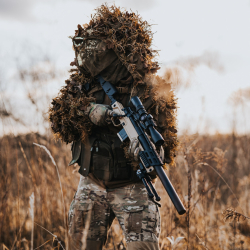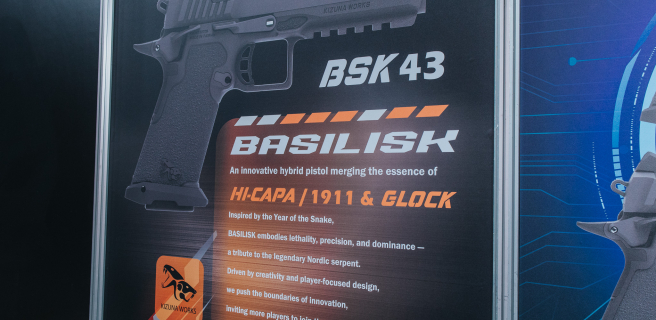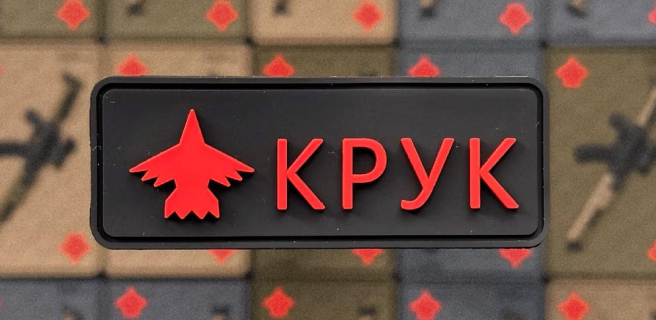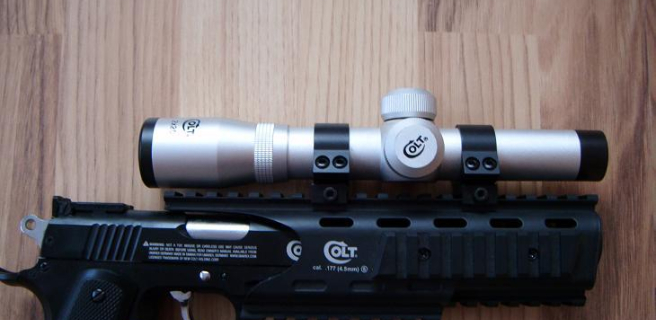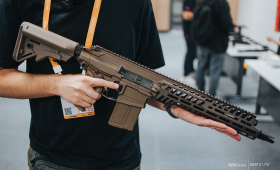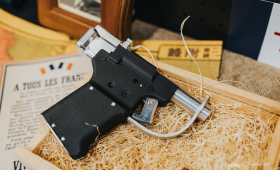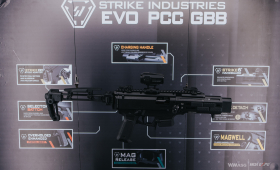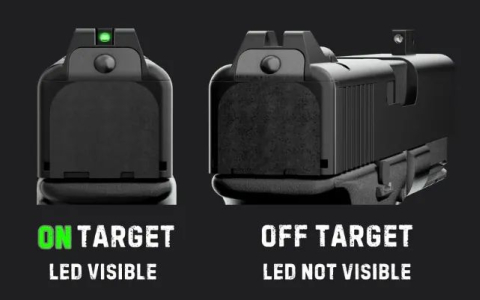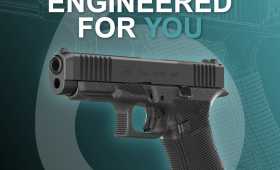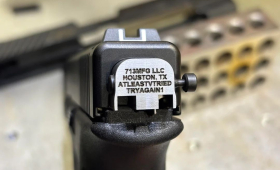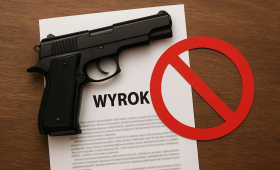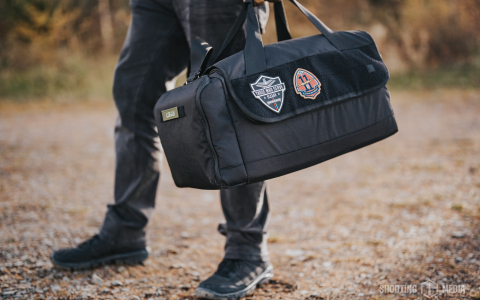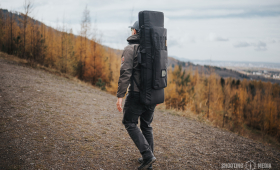LETS START
After a shot while I got another product by Olight - this time it is the Olight HS2 headlamp which emits a light beam of 400 lumens. Looking back at the recent past and... yes, I had the opportunity of testing a light from this company in a similar category - the Olight H1 Nova, which combines the solutions used in angle-head and headlamps.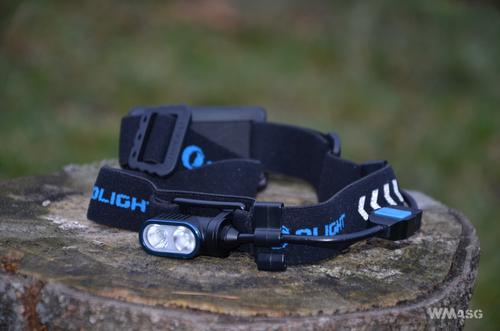
The Olight HS2 is very different from the H1 Nova model. Will it prove itself to be as good in the airsoft use as the model I previously tested?
UNPACKING
The Olight HS2 headlamp is packed in a nice looking, cardboard box, typical for products of this company. This time I will not go into details about how it looks - the box serves its marketing role very well. All the key information and technical specifications that might convince a potential buyer to purchase the lamp are there.
After opening the box a slight deja vu might occur. Inside there is a back and blue case, closed with a zipper with the Olight logo, which came also with the Olight H1 Nova flashlight.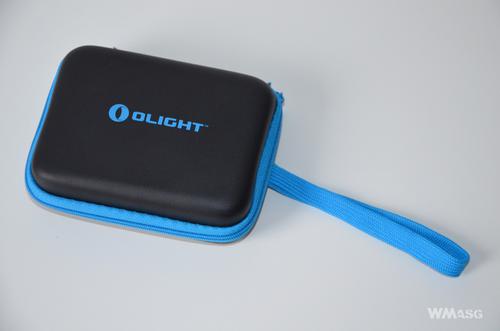
Inside the case are all the parts of the set, yet we will discus them later. The case itself is well made and can be also used as a compact organizer for small EDC type tools. An elastic net installed in the inner side of on one of its halves help with that.
OTHER PARTS OF THE SET
Similarly to other products of Olight, the buyer of the HS2 also get a set of accessories. One of the most important one, the power source (Li-Ion 3,7V 2000mAh battery), comes already mounted in the lamp, which in turn is mounted on the head strap. As the battery is an indispensable part of the device, I will describe it in the paragraph devoted to the design of the lamp.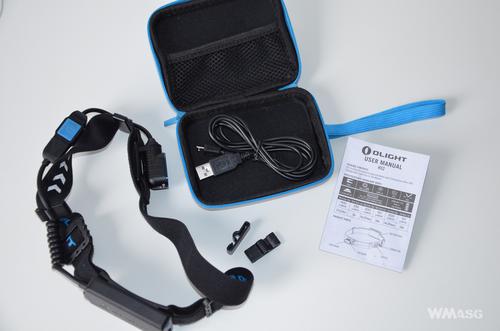
Not taking into account the case, the lamp, the head strap and the battery, there are just a few accessories left:
- an illustrated manual which clearly presents the lamp and how to operate it;
- a USB to Micro-USB converter which allows, among other things, to charge the battery which comes with the set. Of course one can use any other kind of cable of charger;
- spare clips meant to stiffen the cable on the strap.
DESIGN AND PRESENTATION
The Olight HS2 lamp is modular. The following parts are connected with the cable on the strap: the lamp's head, the switch and the power source.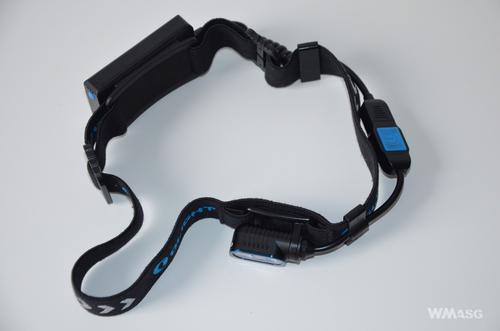
The head of the lamp is made completely of aluminium. Its back and sides have groves which should help dissipate the head from such a small head. It also had the marking stating that it meets all the European regulations, the manufacturer's logo, name of the model and the serial number.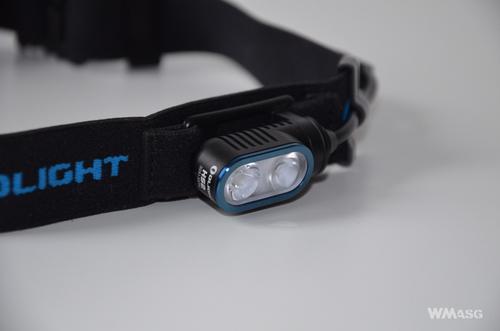
The head is attached to the strap with a plastic buckle with a single lamp holder. This holder is also used to adjust the angle at which the lamp is pitched, just turn the head in the holder and a noticeable resistance will stabilize it in the desired position. The adjustment range is pu to around 180 degrees.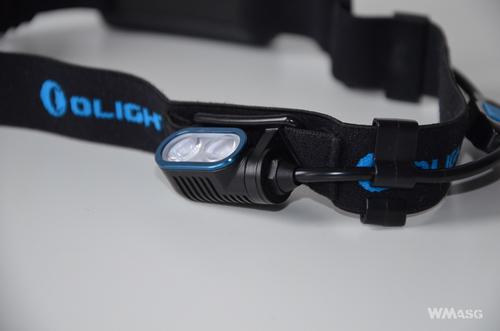
Inside the head are two LED CREE XP-G2 diodes, protected with TIR lenses - one is clear, the other is matte (therefore one gives a very focused beam while the other a dispersed one).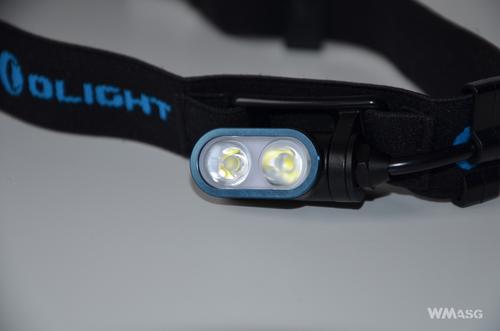
The switch is not situated on the head but on a separate plastic part mounted a small distance away on the strap. The plastic cover also has the Olight logo stamped on it. The switch is made of rubber and slightly convex part which allow one to better feel it under a finger. This part is less noticeable in gloves, yet the size of the switch seems to compensate for that.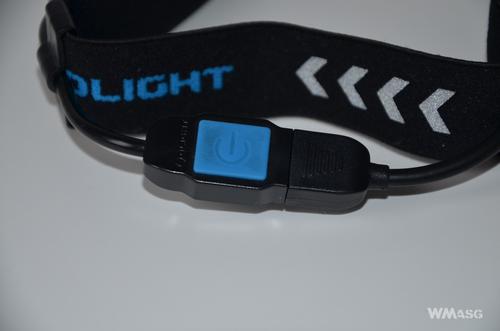
The switch module is also a Micro-USB socket. Quite a bit of strength is needed to pull out the plug. A powerbank's can be connected here in stead of the original battery.
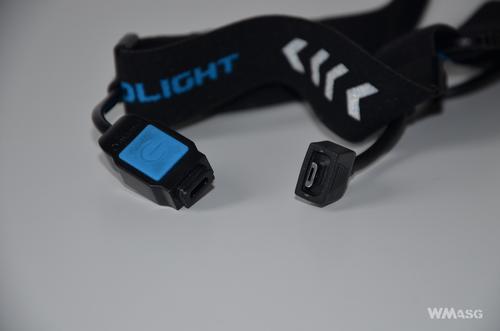
The power source (a Li-Ion 3,7V 2000mAh battery) is enclosed in a plastic casing with an integrated buckle which is put on the strap. The back side of the buckle is covered with a sponge-like material to improve the comfort of wearing it. Similarly to the other modules, the Olight logo is present here as well as norms markings and also the type and parameters of the battery that is inside the casing.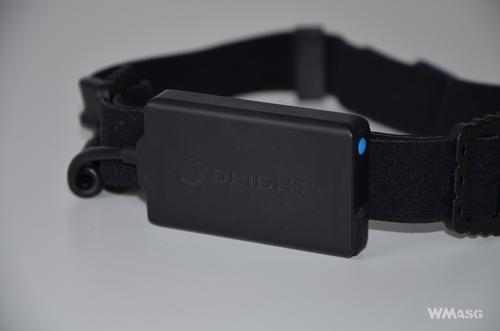
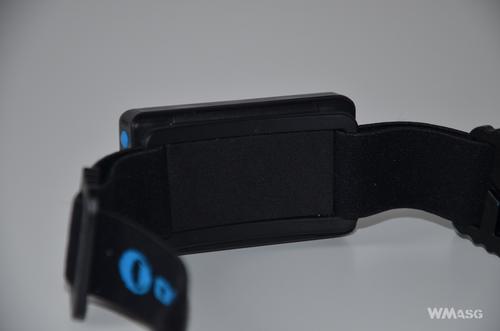
On the side if the battery casing there is a small switch and four blue diodes indicating the battery charge level. Apart from that, under the rubber cover there is a Micro-USB socket which is used to charge the battery.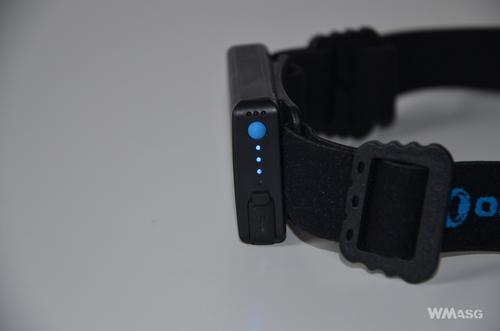
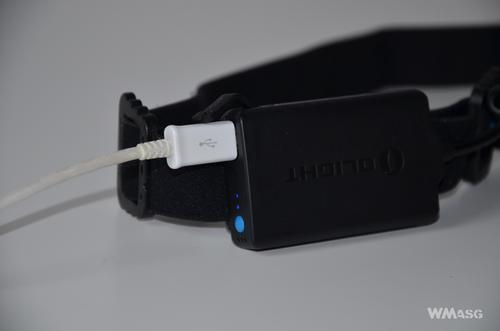
Because of the modular design, the strap does not only serve to mound the lamp on the user's head but also as a guide for the power supply cable. As on all the other parts, the strap also bears the Olight logo. It also has two types of plastic buckles, one used for adjusting the length of the strap, the other for mounting the power cable. The said cable has a spiral, flexible part so we do not have to worry that it will not fit the size of our head.
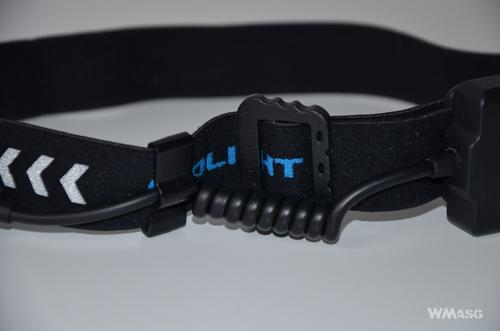
What is interesting are the various resistance norms that the lamp has. The fall resistance class of 1m is quite typical for such devices. But the water resistance class is quite low - IPX4. This means that the device is resistant to rain but is not designed to work under pressurized water nor while submerged. The manufacturing quality is very high therefore the low water resistance norm is probably the result of using the Micro-USB ports (in the plug and under the rubber cover).
OPERATING
The Olight HS2 lamp has 9 different modes of operation. Those are:
- strong mode (400 lumens) and weak mode (100 lumens) with both diodes on,
- strong mode (200 lumens) and weak mode (50 lumens) with flood light diode on,
- strong mode (200 lumens) and weak mode (50 lumens) with spot light diode on,
- SOS mode (400 lumens), with both diodes on,
- SOS mode (200 lumens), with flood light diode on,
- SOS mode (200 lumens), with spot light diode on.
As usual, I will try to fully present all the different modes. Yet, if someone is not interested in the detailed works of the lamp, it is enough to read the shortened version below.
The lamp is turned on by a short press of the switch. Another single press switches between the strong and weak mode. A double click changes the diode used and a triple click activates the SOS mode (using the diode/diodes which were previously used). To turn the lamp off the switch has to be pressed longer. The lamp does not "remember" the last mode used.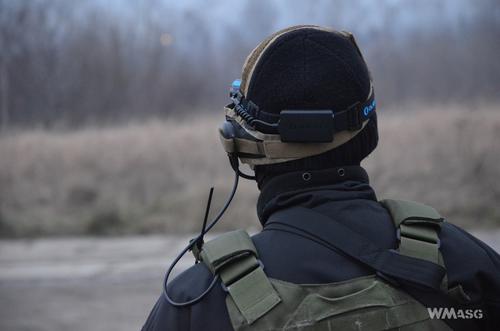
For people that have an abundance of free time or are interested in the details of the lamp's operations, the following paragraphs should be an interesting read.
To turn the HS2 on, one must press the switch. The lamp will fluidly turn on to 100% power (both diodes, strong mode). Another press of the switch will result in fluid decrease of the light beam's power to 100 lumens. Another press of the switch will increase the power to 400 lumens and so on.
It is worth to remember that changing the intensity of the light and turning it on and off is done in a fluid and not instantaneous manner.
Double pressing the switch, when the lamp is on, will turn the spot light diode off and leave the flood light diode on (in the previously used mode - strong or weak). A single press of the switch will change the beam between 50 and 200 lumens (similarly to the earlier case).
Another double press of the switch will, this time, turn off the flood light diode and turn on the spot light diode (in the previously used mode - strong or weak). Similarly, as in the above described cases, a single press of the switch will change the beam between 50 and 200 lumens.
Another double press of the switch will return the device to the first mode in which both diodes are tuned on ("remembering" the power mode used previously).
To turn the lamp off one must press and hold the switch for about two seconds.
A triple press of the switch , when the lamp is on, will turn the SOS mode on. This mode is activated using both diodes or the diode which was used as the last one. In the SOS mode the lamp always works with full power, even if the weak mode has been previously used. A double press of the switch will return the lamp the its normal, continuous operation and the previous diode/diodes used, but will engage the full power mode regardless of the earlier setting.
From the off position, holding down the switch, double or triple pressing it does not turn the lamp on.
It is worth mentioning that after turning the lamp off it will not "remember" the last mode used. Each time you turn the HS2 on you do it using both diodes on full power.
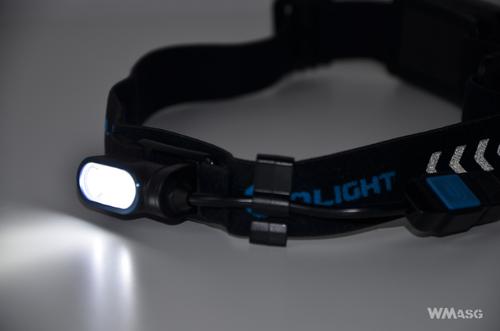
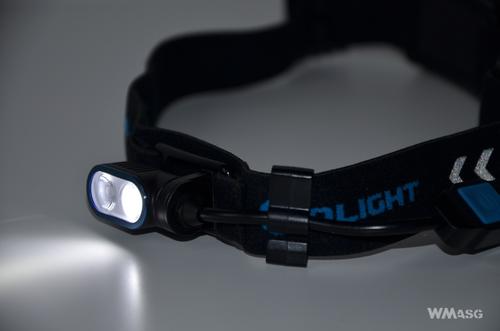
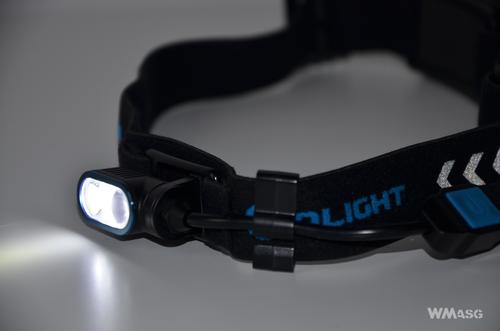
An additional switch can be found on the battery casing. It is used for checking the battery charge level. After pressing the switch diodes light up, indicating the charge level: four (75-100%), three (50-75%), two (25-50%) or one (0-25%). Before the battery is dead a sound signal will inform us about the fact that the charge level is getting low (<10%).
The manufacturer states that the lamp will operate for the following amount of time (using the Li-Ion 3,7V 2000mAh battery supplied with the lamp):
- 2 hours 12 minutes in 400 lumens mode,
- 9 hours in 100 lumens mode,
- 4 hours 30 minutes in any 200 lumens mode,
- 18 hours in any 50 lumens mode.
LIGHT BEAM CHARACTERISTICS
The Olight HS2 lamp uses a cold white coloured beam. The difference between the hot spot and the spill light is the most visible in the spot light and combine modes. In case of the flood light, the beam disperses quite evenly towards the edges.
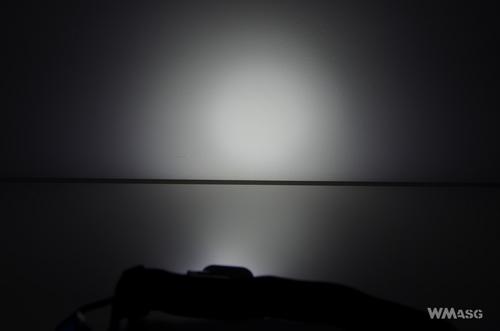
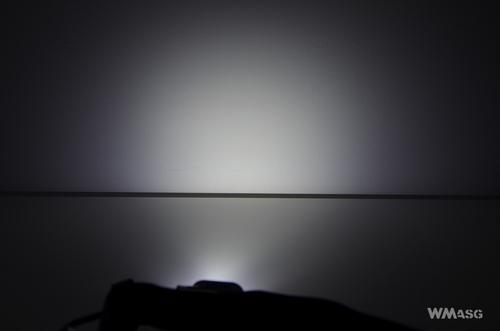
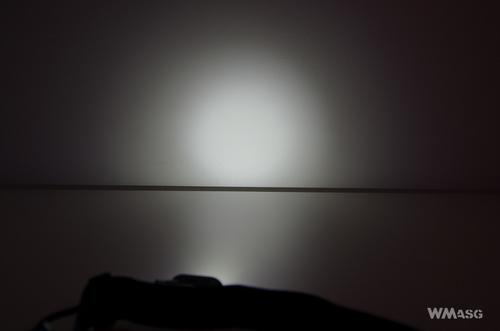
I have compared the light quality of the Olight HS2 lamp (in strong light modes: spot, flood and combined) with various other products producing a flood light beam of: 120 lumens, 340 lumens and 1000 lumens. It is worth remembering that the photos do now show accurately how the flashlight work (they are, unfortunately, much darker), they just show the difference between the light beams.
The photos were mad using a Nikon D5100 camera set on ISO=100, t=2s, f/3.5.
Lets start with a photo showing the terrain where the flashlights were tested during daytime:
120 lumens light beam (Philips Luxeon TX LED):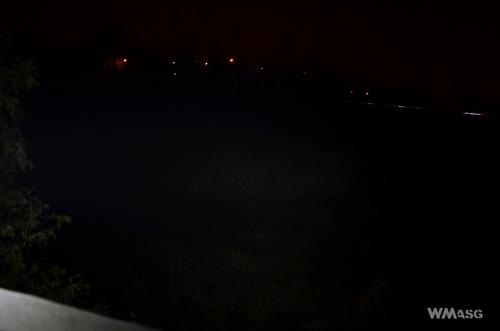
340 lumens light beam+ diffuser (LED CREE XP-L):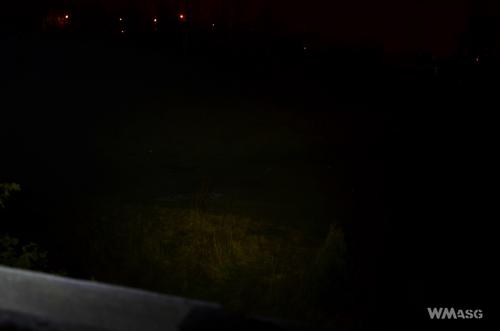
Olight HS2 (LED CREE XP-G2), set as follows: 200 lumens (flood light), 200 lumens (spot light), 400 lumens (combined):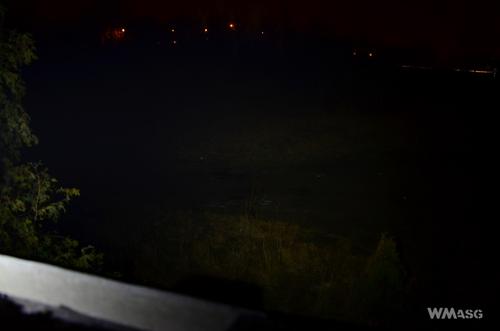
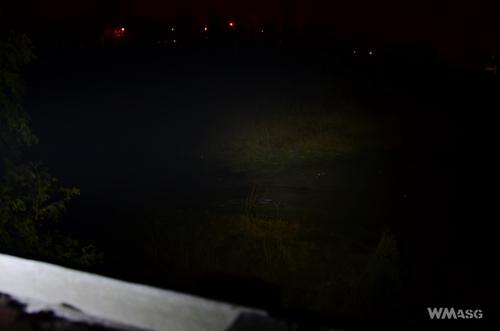
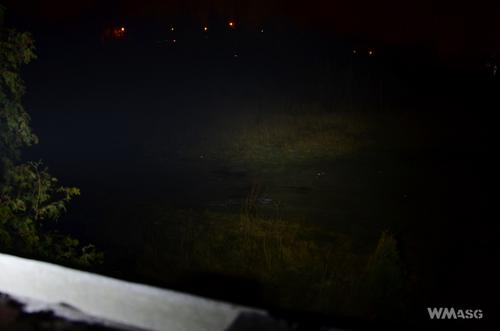
1000 lumens light beam (LED CREE XHP70, low power):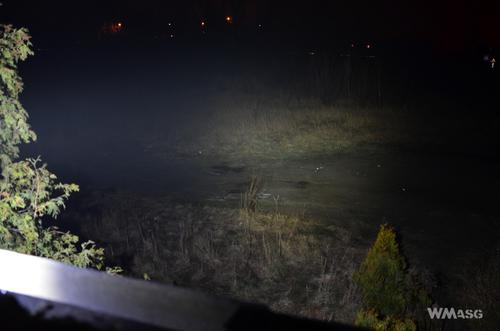
As seen above the brightness of the Olight HS2 head lamps seems adequate to the stated parameters.
FIELD USE
I was able to use the Olight HS2 lamp during one training session in a mixed terrain and also during other activities not related to airsoft. Here I will focus mainly of my conclusions regarding our hobby.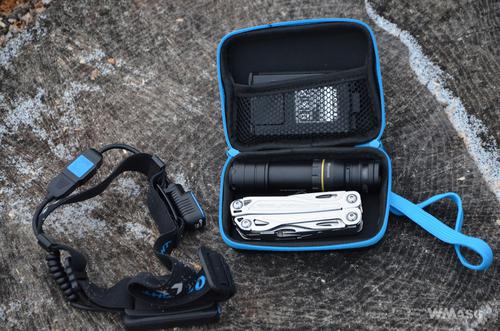
In woodland conditions using the lamp is... difficult. Why, you might ask? 400 lumens in a compact head lamp gives a lot of light over a distance of a few tens of meters (very bleak light may travel as far as 100 meters). This is enough light that spotting the lamp's user is very easy, and simultaneously not enoughto guarantee proper lighting of a half concealed target at a range comparable to the effective range of an AEG. This means that while lighting up the terrain one can easily get caught in a trap and be shot at without noticing the enemy.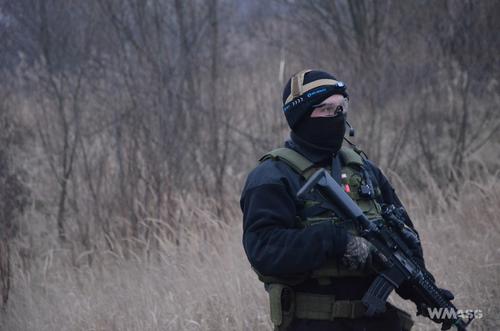
The intensity of the weaker light modes is also strong enough so that its user will be very visible (200 lumens in focused beam mode can still marginally light up an area at 100 meters). Therefore using the Olight HS2 lamp in an area where there might be contact with an enemy is not recommended.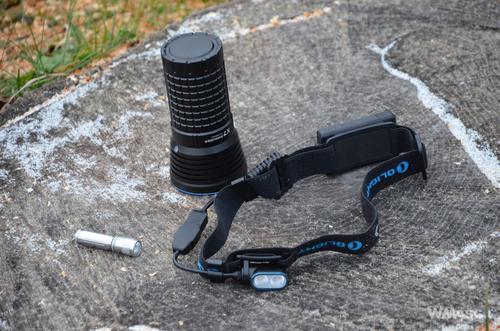
Moving through an area that has a low possibility of enemy contact, where one can use a white light more freely, is a whole different matter. In such a role the Olight HS2 will work very well. 400 lumens will be useful in situations when one will have to light up a wide area in a relatively short amount of timeat night - e.g. during a search for airsoft game related items or the place where the FOB should be set up. Moving around using the 200 lumens flood light mode is very comfortable regardless of the terrain or marching/running speed.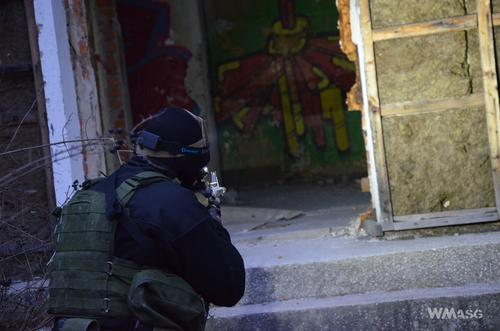
When the duration of operation is the key factor, the 50 lumens mode is still enough to clearly see objects at a dozen of meters ahead (very bleak light lights up objects at about 50 meters). This might be also useful for lighting up a tent. Will it be useful for reading maps or doing minor stuff with ones gear? In such cases even lights of a 100 times smaller strength than the weakest mode on the HS2 are used! Of course, one can use 50 lumens for all that yet it might be necessary to wait while the eyes will accommodate after being exposed to a low light environment.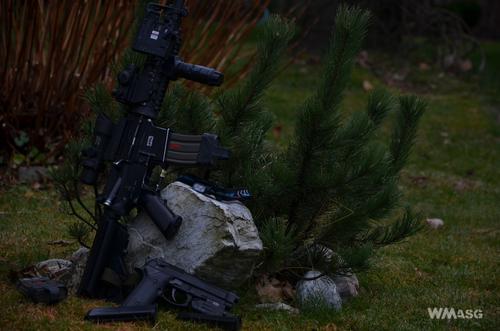
Using the HS2 in CQB is another matter. Here 400 lumens is enough to effectively light up an area and additionally make it harder to the opponents to aim. Yet, one must take into account that a BB might hit the lamp and will have a great chance of destroying it.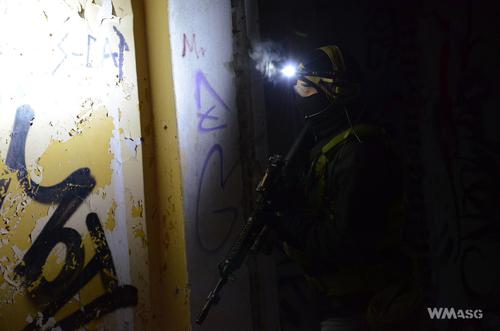
A major drawback in the airsoft use (and grounding me in my conviction that the main target users of this product are not fans of shooting sports) is the fluid turning off of the diode and also the fact that to turn it off one must press and hold the switch, and not just simply press it one. In the airsoft games context, regardless if its a dynamic CQB or mil-sims that are not intended for enemy engagements, an important thing is the ability to quickly turn a light on and off. Often a split second decides if one is spotted or eliminated from the game altogether. Without the full control over this feature using this light might be more damaging then beneficial.
An interesting feature is the possibility to use the lamp with a powerbank. Here, two solutions come into play. One can use a powerbank to charge the battery. This is truely a very useful option if a game is longer then one night. One can also use a powerbank to power the lamp directly! Yet this solution might not be all that useful in airsoft. Depending on the powerbank used it might make the whole "system" quite bulky and cumbersome to use.
SUMMARY
The Olight HS2 a truely multi-functional and in some regard a unique product. Does it make it great in airsoft use? Not necessarily.
Some of the functions and design decisions will surely work in outdoor and professional activities. Powering the lamp from a powerbank? It is a very useful feature but will find little use in airsoft.
As for the light beam characteristic - nothing bad can be said here. The design? Not everyone likes solutions with the power source at the back but this is more of a personal preference. Resistance to falls and water? The latter my be debatable - IPX4 is a bit low judging today's standards.
The rest is, as usual, of top quality, typical for Olight products which I had contact with.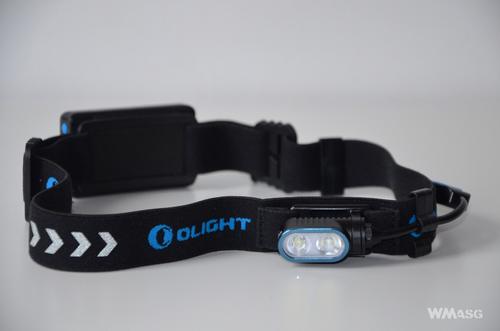
Therefore, if a head lamp will serve you in many different tasks and unconventional solutions are essential to Your plans (charging the battery with a powerbank, splitting the flood light diode from the spot light one, even distribution of weight on the whole head or 7 different modes of operation) - buying the Olight HS2 head lamp is worth considering. The ability to take it to an airsoft game, from time to time, will be an additional benefit. Yet, if the design choices do not meet your needs and the lamp is to be used mainly for airsoft... you are lucky as Olight has many other interesting products in its offer, including an excellent head/angle-lamp Olight H1 Nova.
We would like to thank you Militaria.pl online store for providing us with the lamp for our tests!
Pros:
- high quality finnish;
- maximum beam strength of 400 lumens;
- wide range of light beam adjustment;
- battery included in the set;
- battery charge indicator;
- ability to charge the battery from a powerbank;
- and powering the lamp directly for a powerbank;
- useful case included in the set;
- even distribution of weight on the head (for some)...
Cons:
- ...modular design (for some);
- low water resistance norm (IPX4);
- lack of a very low power mode (in airsoft use);
- necessity to turn off the lamp but pressing and holding the switch (in airsoft use);
- fluid switching off of the diode (in airsoft use);
- it might be difficult to find the switch on the strap at times (especially while using gloves).



